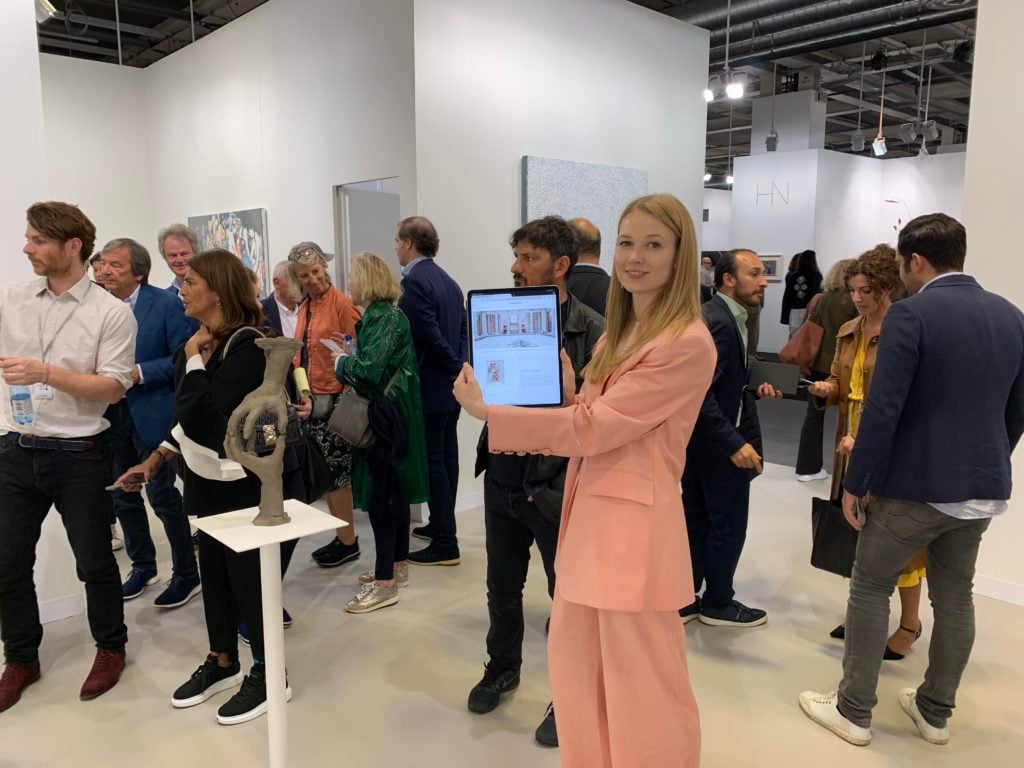Market
What Makes an Effective Online Viewing Room? Here Are 4 Essential Questions Every Art Dealer Needs to Consider Before Launching One
Dealers worldwide are turning to the web to sell art with renewed urgency.

Dealers worldwide are turning to the web to sell art with renewed urgency.

Tim Schneider

With social-distancing requirements having forced thousands of galleries around the world to temporarily shutter their physical spaces since late February, there’s a good chance you’ve heard the phrase “online viewing room” more often in the past six weeks than ever before. Rather than suggesting a fixed concept, however, those three words contain multitudes.
Online viewing rooms can range from simple websites featuring straight-on digital photos of works described with basic details (artist, title, date, etc.), to high-production-value destinations rich in editorial content—and sometimes, even market data. They can be ongoing projects or one-week-only engagements; online offshoots of in-person gallery programming, or independent endeavors entirely. The options seem endless.
One aspect of online viewing rooms is most definitely not endless, though: the amount of time beleaguered galleries have to launch one—at least, if the initiative is going to meaningfully contribute to their salvation in some of the most difficult conditions the trade has encountered in the past century.
To tease out the complexity of the task, below is a quick tour through the strategic questions any dealer needs to answer before launching an online viewing room.

Image courtesy of Wikipedia.
The good news is that, if all you want to do is post thumbnail images in a grid view that allows potential buyers to click through for closer looks at individual works, it’s a relatively light lift in 2020. Dealers with minimal technical prowess can achieve that in-house for a few hundred dollars or less through DIY website-building platforms like Squarespace—assuming good digital images and info are already on file, of course.
Yet one of the most sobering aspects of fine-art e-commerce is how aggressively it smears the boundaries between the supposedly elevated process of collecting, and shopping for literally any other commercial good on the internet. If the goal is to create something that feels more culturally enriching than a visit to a particularly bespoke corner of Amazon, a dealer has to think creatively about the user experience.
Will it take detail shots, installation views, or video footage for the pieces to communicate what they need to online? Would artists’ statements on individual works or gallery-generated write-ups with links to source materials or information on art-historical influences provide useful insight? And most importantly, what can you achieve within your budget and your technical and time constraints? Thoughtful answers will help prevent the onset of digital-mall syndrome.

Marco Fusinato’s Constellations (2015–18) at the Sydney Biennial, 2018. Photo: Zan Wimberley, courtesy the artist and Anna Schwartz Gallery, Melbourne.
For many (if not most) dealers shoved online by the current crisis, the default response will be to simply replicate the programming they envisioned for their brick-and-mortar spaces and mount the same exhibitions the same way on the same schedule, exhibiting all the works in the show together for a dedicated period of four to six weeks, then cycling them out for the next exhibition.
These standards make sense when you have a tangible space with fixed dimensions that most visitors will likely only make the effort to travel to once, but there is no real imperative to proceed this way with an online viewing room. After all, “installing” or “uninstalling” a show only means moving around digital assets, and viewers can easily reach a dealer’s virtual space from the comfort of their homes with the click of a mouse, making multiple visits a more appealing proposition if they have good incentive.
Would it be more compelling, then, to take what was previously planned as a six-week show and subdivide it by rotating in a new grouping of works every week or two? Could you feature two concurrent solo exhibitions that would not physically fit inside your tangible space, but would create a fascinating dialogue in your unconstrained online space? How might artists think differently about what to make now that virtual viewing may be the only viewing available? Being separated from their physical galleries causes dealers some daunting problems, but it could solve others.

Installation view “Kelly Akashi: Mood Organ,” 2020. Courtesy of Tanya Bonakdar Gallery.
It’s not a secret of the ancients that the art market’s fetish for exclusivity has contributed to the slow embrace of digital exhibition and sales platforms. Although norms have been gradually shifting on this front, dealers still tend to be deliberately cagey about how much information they divulge about their inventory, to whom, and after how much vetting. Launching an online viewing room foregrounds these issues, since a virtual space offers fewer monitoring capabilities and visible clues (a fine timepiece on the wrist, recognizable VIP companions, etc.) about who exactly is perusing the available works at any given time.
As a result, galleries have to determine their own personal exchange rate in the internet’s ongoing information trade. Remember, almost anything online can double as a data-collecting opportunity. Do viewers have to give you their email addresses or other professional details for access to your viewing room, or can anyone navigate there anonymously? Are prices and availability visible for every work, or do users have to inquire by email? If the latter, who follows up with the client, by what method, in what time frame—and should your viewing room clearly state this information for accountability’s sake? These are not new questions, but the transition to digital makes them newly salient.

The logo for the video chat app HouseParty. Photo courtesy: HouseParty.
To adapt the old Zen koan: If an online viewing room appears in cyberspace, but no one is around to look at it, does it make an impact? The answer is clearly no.
Every gallery would probably like to believe that it is a meaningful enough destination that clients—existing and prospective alike—will check its website of their own volition, or at least click through the link in an announcement email or a social-media post. Yet the competition now raging in people’s inboxes and timelines has never been fiercer, making it increasingly unlikely that your online viewing room will win collectors’ valuable attention without you making more than a token effort.
Instead of hoping mass emails and Instagram posts will lead to passive viewing, the greater value lies in stoking social engagement with your audience. Can you activate your online space by, say, holding a publicly accessible Zoom webinar with artists and curators about your current exhibition, or even weekly “remote cocktail receptions” on HouseParty, where fans can discuss the works book-club style? Could you use your social-media accounts to initiate ongoing, in-depth conversations with commenters instead of simply posting and ghosting? Most counterintuitively, why not leverage your online viewing room as an opportunity to personally reach out to your collectors by phone or email to refresh or reinforce the relationships that matter most?
In the end, successfully selling art in a virtual space still depends on the same elements as selling art in a physical space: thoughtful presentation, a willingness to think past the status quo, a clear and consistent philosophy about how to distribute information, and the recognition of art’s value as a cornerstone for community-building. Applying these concepts to an online viewing room isn’t easy, especially with so little time to spare—but that’s precisely why it’s so important.